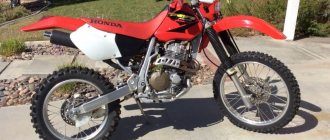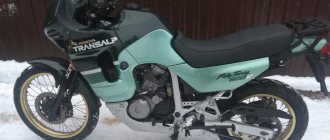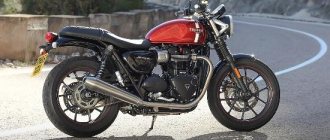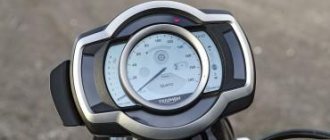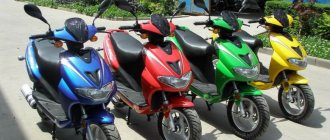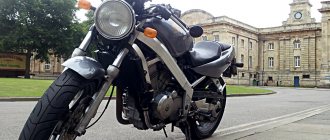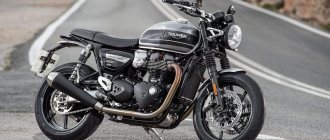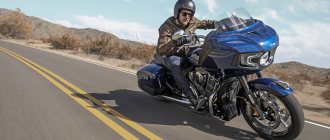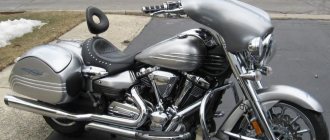Triumph America Review
Triumph America is a cruiser originally from England, despite the word “America” in the name.
Stylish and unusual, it is guaranteed to attract many looks. English motorcycles are quite rare guests on our roads, which is due to their rather high price, as well as the established opinion about the dubious quality of English equipment at the same time. Triumph America glitters in the sun so much that it hurts your eyes. There is definitely no shortage of chrome on the thoroughbred Englishman, and this chrome is of very high quality, judging by the old motorcycles, on which the chrome coating is generally in excellent condition. In the class of choppers and cruisers, chrome is held in high esteem; there should be a lot of it on any bike, well, with the exception of matte black versions. The Triumph America is powered by an 865cc inline-two. cm, producing 62 power. This motor is very torquey, without obvious hesitations or dips, and confidently pulls the motorcycle forward in any gear. Subjectively, in terms of its characteristics, it is much closer to classic chopper V-twins than to the high-speed in-line engines of most other motorcycles. Although for the British, in-line engines on their motorcycles are as classic as the V-twin for the Americans.
In early versions of motorcycles, the engine is powered by a carburetor, but a few years ago, injectors began to be installed on the new Triumph America, which made it possible to slightly reduce fuel consumption in the same modes - it must be admitted that the injector is still more economical than the carburetor. Otherwise, this model remains virtually unchanged from year to year, with the exception of the available coloring options.
Wheels of the same size, and even with alloy wheels instead of classic spoked rims, visually make the Triumph America long and low - all according to the canons of a cruiser style. The English could never be blamed for their lack of taste. Literally everything about this motorcycle screams about an aristocratic breed - all this chrome, precise lines, the chic quality of the paintwork and seat upholstery. It feels like not only the designers, but also the designers did a good job on Triumph America.
True, if you remove the seat with the side covers, or, for example, the gas tank, and look, so to speak, into the insides of the motorcycle, you immediately remember why English quality is sometimes spoken rather unflatteringly. Untidy hanging bundles of wires, lack of proper painting, thick and crooked seams - all this can easily be hidden behind a beautiful wrapper. At least, on several of the motorcycles inspected, this was exactly the case. It seems like nonsense, but still... However, Triumph America is a motorcycle for the soul. This type of equipment is loved not for its technical characteristics, albeit very high ones, but for its style, and for the sake of this style, all minor flaws are forgiven.
Regarding the Triumph America suspension, we can say that it does exist, and that it is no worse or better than that on most other choppers and cruisers. She is, so to speak, simply average, and at the same time practically the embodiment of the standard in her class.
When choosing a motorcycle, you should pay attention to Triumph America if you want to stand out by purchasing such unusual equipment for the CIS countries. As a result, you will get an excellent mid-sized motorcycle, with characteristics very close to, for example, the Honda VT 1100 Shadow or Yamaha XVS 1100 Drag Star. But the Triumph, unlike them, is very rare, and the atypical engine for a cruiser, thanks to proper tuning, will not cause rejection even for a biker accustomed to V-twins. The only thing that is questionable is the chain drive - this is a rarity for modern choppers. The belt would be more technologically advanced, but the designers apparently know better.
Triumph company as a motorcycle manufacturer - history
By September 1991, the company had launched production of three pairs of new models - Trophy, Daytona and Trident, presented at the Cologne exhibition in 1990.
These were two Trident motorcycles, with engines of 750 and 900 cc and without fairings, Daytona sports motorcycles, with engines of 750 and 900 cc. and full fairings, Trophy touring motorcycles with fairings and engines of 900 and 1200 cc.
At this time, the company produced very few motorcycles - no more than eight per week.
By 1996, production increased to 15,000 motorcycles; enduro motorcycles Tiger 900, Sprint, retro model Thunderbird, Adventurer were launched into series.
The models being produced were gradually re-equipped; competition with well-known motorcycle companies, Honda and Ducati, forced Triumph designers to develop new motorcycles with technical characteristics that were ahead of their time.
As a result, in 1997, the T595 Daytona model, stunning in its appearance and technical characteristics, was released, which allowed the Triumph brand to once again become an elite motorcycle manufacturer.
The year two thousand was marked by the release of the ninety-thousandth English motorcycle of the Triumph brand. The year before, the company began construction of a new plant with a projected production of fifty thousand motorcycles per year.
Initially, Triumph motorcycles originated from Great Britain; we can say that England is the country producing Triumph motorcycles. Today, Triumph has its divisions in the USA, Canada, France, Germany, Belgium, Austria and several others.
Currently, the Triumph motorcycle lineup includes a fairly large number of modifications with engines ranging from six hundred to two thousand three hundred cubic cm.
The company's calling card is a three-cylinder engine, also of various sizes with four-valve heads, an injection system and a liquid cooling system, which are equipped with most of the motorcycles produced.
Triumph → Triumph America 2010 cruiser review
Previously, we reviewed the new Triumph Speedmaster 2010 cruiser, now let's move on to a review of the Triumph America motorcycle, which has much in common with the above mentioned model. America has more classic design features and perhaps more practicality.
Cruisers always have sleek and flowing design lines, a symphonic engine and a comfortable riding position, and the Triumph America is no exception. As for the engine, it is from the classic genre - Bonneville: 865 cm3, DOHC, air-cooled, two-cylinder, in-line.
Like all previous years, the 2010 America comes with a five-speed transmission, chain drive, and a 15-inch rear wheel with 170 mm tires. At the front there is an 18-inch wheel with a 110 mm tire. Both front and rear are fitted with 310mm and 285mm single disc brakes respectively.
The 41mm America forks are set at 33.3* which is great and gives the bike a nice classic look. But don't forget that the Triumph America, a true cruiser with a steel frame and swingarm, weighs 250 kg. Thanks to the low center of gravity and 60 hp engine power, the weight may not be felt as much. As with the Bonneville, America received an injector for environmental reasons.
• Engine: Air-cooled, DOHC, twin-cylinder, in-line • Displacement: 865 cc • Bore x Stroke: 90 x 68 mm • Compression Ratio: 9.2:1 • Fuel System: Multiport Sequential Electronic Fuel Injection with SAI • Final Drive: Chain • Clutch: oil bath multi-plate clutch • Gearbox: 5 speeds • Power: 60 hp at 6800 rpm • Torque: 72 Nm at 3300 rpm • Frame: Tubular steel • Front Wheel: Aluminum alloy, 12 spoke, 18 x 2.5 • Rear Wheel: Aluminum alloy, 12 spoke, 15 x 3.5 • Front tire : 110/90 R18 • Rear tyre: 170/80 B15 • Front suspension: 41mm Kayaba forks, 130mm travel • Rear suspension: Kayaba shock absorbers, adjustable, 96mm travel • Front brake: 310mm disc, Nissin caliper 2-piston • Rear brake: 285mm disc, Nissin 2-piston caliper • Length: 2418mm • Width (Handlebar): 960mm • Height: 1168mm • Seat Height: 719mm • Wheelbase: 1654mm • Tilt/ Trail: 33.3* / 153 mm • Wet weight: 250 kg • Fuel tank capacity: 19.3 l
Appearance Rocket III
This motorcycle looks really gorgeous. Nothing superfluous, only what is necessary, everything is massive and serious.
The large front wheel covers the top of an equally massive wing. The edges of a wide cooling radiator are visible behind the wheel.
The tilt angle of the fork is not particularly large, which is dictated by the weight of the motorcycle itself; at a higher angle, the fork could not withstand it for a long time. Wide-set front fork stays made it possible to install two headlights at the front.
The handlebars are quite wide, but the motorcycle is massive and you need a good handlebar to control it. On the latest models, the dashboard is presented in the form of two wells with sensors located above the steering wheel.
The tank is quite wide and voluminous, its shape fitting well into the appearance of the motorcycle.
The seat is double, separate. The seat level is relatively low, which only adds to the stability of the motorcycle.
The passenger seat is located on the rear fender, which ends with a small oval brake light. Below the seats are small glove compartments.
Triumph Thunderbird tail light
What is a “cruiser in English”? I had the opportunity to try out a pre-production Triumph Thunderbird prototype before the official press test. However, if the car differs from the serial one, it is only a little. I must warn you right away: this motorcycle is much better “live” than in the photographs. Designer Tim Prentice managed to create an unusually successful image of how the metal frame envelops the impressively sized engine. Moreover: the device is harmonious - you must admit, this cannot always be said about a cruiser. And the blue paint with white marking stripes brings to mind the AC Cobra - an Anglo-American four-wheel hybrid, a large V8 Yankee tank in the chassis of a light British sports car.
Triumph Thunderbird panel
I throw my leg over the low - 702 mm - saddle (sorry, Dmitry, but your malice * will not force me to change my signature style) - and find the fit quite comfortable. The saddle is soft, but not excessively - there is no feeling that the foundation of the back (as the British call the “fifth point” - editor’s note) has fallen somewhere. The visibility is excellent, despite the low seat height, and the chrome headlight housing cuts through the air like the bow decoration of a sailboat. The large - 21 liter - gas tank is somewhat reminiscent of the British super classic - Brough-Superior motorcycles, but at the same time it does not force you to spread your knees too wide, to the point of losing the feeling of contact with the motorcycle.
Links
- Abingdon (AKD) (1903-1925)Advance (1905-1947)AER (1937-1940)AJW (1928-1976)AJS Motorcycles Ltd (1909-2000)Alldays & Onions (1903-1915)Ambassador (1946-1964)Ariel (1902–1970)Armstrong (1980–1987)Ascot-Pullin (1928–1930)AMC (1937–1966)Baker (1927–1930)Bat (1902–1926)Baughan (1920–1936)Beardmore Precision (1914–1930) Blackburne (1913–1922) Bradbury (1902–1924) Brough (1908–1926) Brough Superior (1919–1940) BSA (1919–1972) Calthorpe (1909–1939) Chater-Lea (1900–1936) Clyno (1909–1923) )Corgi (1946–1954)Cotton (1918–1980)Coventry-Eagle (1901–1939)Coventry-Victor (1919–1936)DMW (1945–1971)DOT (1908–1978)Douglas (1907–1957)Dunelt (1919) –1935)Duzmo (1919–1923)EMC (1947–1977)Excelsior (1896–1964)Francis-Barnett (1919–1966)Greeves (1953–1976)Haden (1912–1924)Hazlewoods Limited (1895–1923)Healey ( 1971–1977)Hesketh (1981–1988)Humber (1898–1930)HRD (1922–1928)Ivy (1911–1934)James (1902–1966)JAP (1903–1939)Levis (1911–1939)Martinsyde (1919– 1923)Matchless (1899–1966, 1988–90)McEvoy (1926–1929)Montgomery (1902–1939)Ner-a-Car (1921–1926)New Hudson (1903–1958)New Imperial (1901–1939)Norman ( 1935–1963)Norton-Villiers (1966–1972)Norton Villiers Triumph (1972–1978)NUT (1912–1933)OEC (1901–1954)OK-Supreme (1882–1940)P&P (1922–1930)Premier (1908– 1921)Panther (1904–1967)Quasar (1975–1982)Quadrant (1901–1928)Raleigh (1899–1967)Rex-Acme (1899–1933)Rickman (1960–1975)Rover (1902–1924)Royal Enfield (1893) –1971)Ruby (1909–1932)Rudge (1911–1946)Scott (1908–1965)Silk (1976–1979)Singer (1900–1915)Sprite (1964–1974)Sun (1911–1961)Triumph (1885–1983) )Tandon (1947-59)Sunbeam (1912–1964)Velocette (1904–1971)Villiers (1898–1966)Vincent-HRD (1928–1959)Wilkinson (1911–1916)Wooler (1909–1954)Zenith (1905–1950) )
Closed ABC (1919–1923)
Triumph Thunderbird
I’ve known my partner on the 100-kilometer raid along the mountain roads of Catalonia for a long time. We once raced together, and now 34-year-old David Lopez is a test driver for Triumph. It is he who should be thanked for the fact that the Thunderbird is head and shoulders above its rivals from the USA and Japan in terms of handling. The Showa suspension installed on the motorcycle is clearly the best in this class - and this despite the fact that all adjustments are limited to changing the spring preload of the rear shock absorbers. There is no comparison with the hard-assed “softails” - it looks more like a solid roadster. However, let’s hurry after David to the foothills of the Pyrenees - the winding and damn narrow roads there, the arena of battles at the Costa Brava rally world championship, will give a complete picture of handling. Of course, with such a wheelbase - 1641 mm - and the corresponding steering geometry, the motorcycle cannot help but show some laziness, and the ground clearance is low - a tribute to style!
Triumph Thunderbird fork
But still, the car is controlled with unexpected ease - and you can’t tell that it has 305 kg of dry mass. It’s good that its creators did not succumb to the temptation to push the rear “cylinder” by 250 millimeters, like many competitors. The Metzeler rear tire is a decent size 200/50-17, just like a sportbike! But “sports” do not have such a steering wheel to steer the motorcycle into a turn. So the British cruiser clings to the road with commendable zeal, handles well and shifts into S-shaped turns with an agility that is completely unexpected with such a chassis geometry. Of course, you won’t be able to corner the motorcycle in such a way as to scrape the asphalt with your elbow, but the bike is extremely stable when cornering at high speed. And the brakes are simply magnificent by class standards! I've ridden all sorts of cruisers - American, Korean, even Australian and Chinese - and believe me, no competitor has such brakes. But if the driver is accustomed to conventional cruiser brakes, then he will have to change his skills and use not only the rear, but also the front brake. The instrument panel with a large speedometer and integrated tachometer and LCD display is located on the gas tank.
Triumph Thunderbird frame
The direction indicators are automatically switched off as soon as you enter a straight line. And the chrome mirrors are simply perfect: no vibrations and excellent visibility. Other manufacturers should learn from this! But the real gem is the engine. He confidently accelerates the motorcycle in top gear from 1500 rpm - this is with the throttle fully open, but if the throttle is only half open, then it pulls from 1000 rpm. But this is only slightly higher than the idle speed - 850 rpm. The cruiser is very easy to control at low speed, even tight turns do not bother you - the chassis is perfectly balanced, and the cable-driven clutch is quite predictable. And what a pleasure it is to rush along the motorway at a speed of 130 km/h - the tachometer needle lies at 3500 rpm, only halfway to the red zone. At the same time, the pulsating sound is just like that of a V-twin: after all, the crankshaft cranks are spread 270 degrees. Two balance shafts effectively dampen any vibration - up to the maximum 6500 rpm. But the most comfortable range is from 1800 to 4000 rpm, when the torque is so great that you can easily take on the steepest climbs.
"Triumph America" - a motorcycle of the best traditions of British cruisers
The basis of the Triumph America design was developed so long ago that the cruiser at first glance looks like a true biker classic: a steel duplex frame tightly envelops the engine, the parts are adjusted so that there are absolutely no unnecessary structural elements. The bike looks in the tradition of the best motorcycles of the 60s, but behind the retro appearance hides a powerful, modern cruiser, made using the latest technologies from.
One of the main qualities of a cruiser is comfort; the Triumph America developers created the motorcycle with true concern for the pilot: updated ergonomics with a lowered seat (height 69 cm) allowed the driver to position himself closer to the controls. Moderately forward footpegs, a wide handlebar mounted close to the pilot - all this provides a comfortable classic seating position for a driver of any height. The stylish look of the cruiser is emphasized by a polished 41mm fork set at an angle of 33 degrees, alloy wheels, chrome headlights and many other design elements.
Smooth, classic biker lines, a comfortable fit, a sonorous engine - for all the necessary functionality, the Triumph America could be called a purely classic cruise motorcycle. But... this is a true Briton, different from the bulk of motorcycles in its class. Only in the Triumph America cruiser can you truly appreciate the parallel V-twin, which gives the motorcycle not just a special style, but also confidence on any road. All this is thanks to a powerful engine and a special design that ensures a low center of gravity of the bike. The 860 cm³ two-cylinder engine (with a maximum of 60 hp - 6800 rpm) provides smooth but confident acceleration. The speed obediently responds to the throttle. Gears (5 steps) change easily and freely. The Triumph America's rear and front hydraulic disc brakes with 2-piston calipers stop the car very confidently, creating a safe stopping distance. The instrument panel is conveniently located at the base of the steering wheel and is easy to read.
"Triumph America" is a comfortable, stylish representative of the cruiser class, made in the best British traditions. In its own way, this is a completely unique motorcycle - it is one of the lightest in its class (250 kg). It's a car that handles and rides superbly, and the Triumph America design is a true English classic, ensuring that it turns heads wherever this wonderful cruiser goes. .
T 140 Bonneville 1973–1988
The Bonneville T 140 model was produced in the following modifications:
T 140 V
Original model
T 140 RV
was an export version of the T 140 V with engine modifications to suit US market requirements and the gear lever switched to the left side to meet 1974 requirements.
T 140 J
The T 140 J was limited to 1,000 examples in the US and an additional 1,000 in UK specification (plus 400 for Commonwealth export) T140V, produced to commemorate the 1977 Silver Jubilee of Queen Elizabeth II. The idea came from Lord Stokes, who was chairman of British Leyland and worked as a consultant to Meriden Co-operative.
Used silver trim with red and blue lining and matched with a blue saddle with red beading. The primary drive, taillights and chrome caps were chromed, and the wheel centers were painted and aligned. The side panels with the US version had "One Thousand" written underneath the Union Jack lettering, the side panels with the UK version had "Limited Edition" and the remaining 400 motorcycles for Commonwealth export were marked "International Edition". Quickly created as a collector's item, each car received a unique certificate of ownership
T 140 D
Launched in 1979 and designed by Tom Higham of Triumph, the Triumph T 140 D Bonneville Special was a styling exercise inspired by the Yamaha XS 650 Special. The model suffered several changes such as an overhead mounted rear caliper and a revised grabrail became standard on the T 140 E. Bonneville Specials were made in black gold with a slim seat and seven-spoke magnesium Lester aluminum wheels and a tuned two-into-one exhaust for the American market . The T140D had polished fork sliders AND a shortened chrome mudguard mounted to its center support bar
T 140 AV
Designed by engineers Brian Jones and Bernard Hoeper, the Bonneville T 140 AV was originally designed for police use, featuring an anti-vibration system, a rotating console that was rotated and attached to the engine, which itself was isolated by rubber mounts from the chassis. The engine balance has also been revised.
T 140 LE
The "Limited Edition" was championed and each came with an owner's certificate signed by the dealer and Triumph Chairman. Just 250 of these cars were produced (with special styling for 125 American and 125 British models) to commemorate the 1981 marriage of Lady Diana Spencer and Charles, Prince of Wales. The UK version had a silver gray painted frame and black finished engine, while the export version had gray seat covers and a polished engine with silver cylinders. While in both cases an electric starter, Bing carburetors, ULO turn signals and Marzocchi Strada rear shock absorbers for the rear nuts were standard, the British version also had American-made Morris alloy wheels and twin front discs. Both versions' petrol tanks were chrome-plated, but had a different look: The 4-gallon British tank featured a simple Triumph badge with black scallops echoing the color of the side panel; and the 2 gallon export tank had the old Triumph frame and had gold lined "smoky" blue scallops that matched the color of the side panel. Where both tank types attach to the frame was covered with a badge reading "Royal Wedding 1981", while both side panels featured the legends "Bonneville", "Royal" and "1981" with stylized Prince of Wales feathers, the symbol of the Prince of Wales. There were also motorcycles exported to the United States to Triumph Motorcycles America specification. They were like the British ones, but with black frames and black tanks with gold lines. The Prince of Wales feathers on their sidebar icons were retained next to the word "Royal", but the 1981 date was removed. Their engines were painted black like the British version, but with polished finishes like the American version.
T 140 TSX
Designed by Wayne Moulton of Triumph Motorcycles America, the Triumph T140 TSX was specially equipped with a 16-inch (41 cm) rear wheel, Morris alloy wheels, stepped seat, and special trim and detailing. It was the only Bonneville designed by an American. In addition, the model was equipped with an electric starter and two front brakes.
T 140 E
Launched in 1978, the "E" stood for emissions compliance. This model featured a new cylinder head, rebuilt Amal carburetors to meet emissions regulations and, shortly after production began, Lucas electronic ignition. Most "E" models had many design improvements, including new Lucas switchgear, a new side panel design, and passenger grabbers that contained a small parcel rack. There was also a 1980 T140E Special Edition with a hard rack, fairings and special two-tone paint.
T 140 ES
The model was equipped with an electric starter; an electric starter was also installed on the T 140A V, TSS and TSX models.

